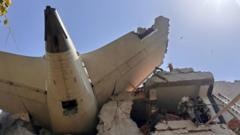On June 12, 2025, an Air India flight bound for London tragically crashed just seconds after takeoff in Ahmedabad, leading to the deaths of more than 260 individuals, marking it as one of India's deadliest air disasters in recent history.
# Tragic Air India Plane Crash Claims Hundreds of Lives

# Tragic Air India Plane Crash Claims Hundreds of Lives
A devastating aviation disaster unfolds in Ahmedabad, India, as an Air India Boeing Dreamliner crashes shortly after takeoff, resulting in a staggering death toll.
An Air India Boeing Dreamliner, identified as Flight AI-967, took off from Sardar Vallabhbhai Patel International Airport in Ahmedabad but went down almost immediately, crashing into a local medical college situated nearby. Officials reported that all but one of the 241 passengers aboard perished in the incident, with the flight's sole survivor being identified as Viswash Kumar Ramesh, a British national. Eyewitness videos captured chilling moments before and after the crash, showing the plane seemingly gliding before a massive explosion erupted.
As details emerged, Ramesh, who was traveling with his brother Ajay, managed to escape the wreckage amidst devastation. In a video call with his brother, Nayan Ramesh, he expressed disbelief at his survival, stating, “I can’t see my brother; I can’t see any other passengers.”
The incident has sent shockwaves across India and raised questions concerning aviation safety and regulations, as this tragedy marks the country’s most catastrophic airline crash since 1996. Indian authorities have launched an investigation into the catastrophe, prompting discussions surrounding infrastructural safety measures and emergency protocols for aircraft operations near populated areas.
Global reactions have included condolences from numerous world leaders and calls for thorough investigations into aviation regulations. As the nation mourns the loss of life, airlines in India, alongside civil aviation authorities, may face heightened scrutiny in their adherence to safety protocols to safeguard against future disasters.
As details emerged, Ramesh, who was traveling with his brother Ajay, managed to escape the wreckage amidst devastation. In a video call with his brother, Nayan Ramesh, he expressed disbelief at his survival, stating, “I can’t see my brother; I can’t see any other passengers.”
The incident has sent shockwaves across India and raised questions concerning aviation safety and regulations, as this tragedy marks the country’s most catastrophic airline crash since 1996. Indian authorities have launched an investigation into the catastrophe, prompting discussions surrounding infrastructural safety measures and emergency protocols for aircraft operations near populated areas.
Global reactions have included condolences from numerous world leaders and calls for thorough investigations into aviation regulations. As the nation mourns the loss of life, airlines in India, alongside civil aviation authorities, may face heightened scrutiny in their adherence to safety protocols to safeguard against future disasters.





















